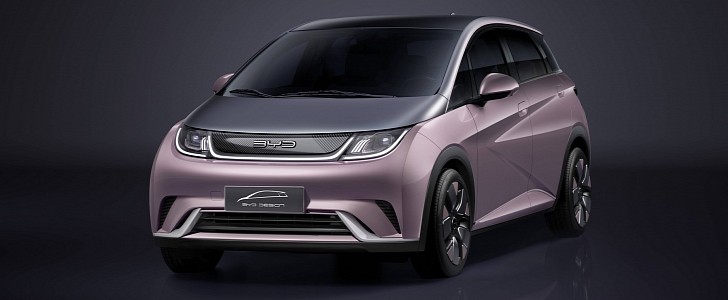When you have already written or read a lot about a vehicle, you expect new things about it to bring more information than what you had so far. Checking how the BYD Dolphin drive was what first attracted us to check the Fully Charged video about the new EV. Apart from the images, we have to say it offered very little that we did not know, but it was an excellent opportunity to complement what we missed.
The main characteristic about the Dolphin that we still did not know is that it offers V2L (vehicle-to-load), something Elliot Richards uses to heat his hot pot lunch. We also had no idea that would provide a six-year or 150,000-kilometer (93,206-mile) warranty on the car. The BYD Dolphin’s prices in China start at RMB93,800 ($14,545 at the current exchange rate). The most expensive one costs RMB121,800 ($18,887) and offers an NEDC range of 405 km (252 mi).
What Richards did not mention in his video is that the Dolphin is the first really affordable car to offer an 800V system with an LFP (lithium iron phosphate) battery pack, two elements that make it a remarkable EV. The video presenter says that it is little, but it is slightly larger than a Honda Fit/Jazz, at 4.07 meters (160.2 inches) long, even if its platform allows it to offer a much longer wheelbase: 2.70 m (106.3 in).
LFP batteries are now leading production numbers in China. Although they present a lower energy density than ternary cells, they are considered much more robust and safer, with fewer risks of thermal runaway episodes. They can also be charged to 100% of their capacity regularly, something that manufacturers do not recommend that you do if your car has NMC or NCA batteries.
With these cells working at 800V, the Dolphin can charge very quickly. BYD states that it can recover 150 km (93 mi) of range in only five minutes with adequate fast chargers. If you could find them in multiple locations along the way in a road trip, you could buy the more affordable Dolphin with no concerns about the 301 km (187 mi) of NEDC range that the 30.72-kWh battery pack offers. Theoretically, you would only need to make two five-minute stops to travel 600 km (373 mi) if you left with a full charge.
With the LFP battery pack, you could even do that with a reasonable frequency with no concerns for how long it would last. BYD said the Blade Battery could stand 1.2 million km (745,645.4 mi).
Another point that the video should have addressed better is the name of the architecture the Dolphin introduced. BYD calls it e-platform 3.0, not Ocean, as Richards said. One of the future cars BYD plans to present with the new platform is so far known only as ocean-X. Although it was just a concept, we do not doubt it may retain the same name in production form.
According to the video presenter, BYD did not confirm if it will call the Dolphin like that when it begins to sell it abroad. When it reaches Europe, it may be called only EA1, its development codename. We think that Dolphin could be a good name unless it means something else in the languages of the EV’s target markets. That’s why the Fit is called Jazz in Europe and why the Hyundai Kona changed its name to Kauai in Portugal.
What Richards did not mention in his video is that the Dolphin is the first really affordable car to offer an 800V system with an LFP (lithium iron phosphate) battery pack, two elements that make it a remarkable EV. The video presenter says that it is little, but it is slightly larger than a Honda Fit/Jazz, at 4.07 meters (160.2 inches) long, even if its platform allows it to offer a much longer wheelbase: 2.70 m (106.3 in).
LFP batteries are now leading production numbers in China. Although they present a lower energy density than ternary cells, they are considered much more robust and safer, with fewer risks of thermal runaway episodes. They can also be charged to 100% of their capacity regularly, something that manufacturers do not recommend that you do if your car has NMC or NCA batteries.
With these cells working at 800V, the Dolphin can charge very quickly. BYD states that it can recover 150 km (93 mi) of range in only five minutes with adequate fast chargers. If you could find them in multiple locations along the way in a road trip, you could buy the more affordable Dolphin with no concerns about the 301 km (187 mi) of NEDC range that the 30.72-kWh battery pack offers. Theoretically, you would only need to make two five-minute stops to travel 600 km (373 mi) if you left with a full charge.
With the LFP battery pack, you could even do that with a reasonable frequency with no concerns for how long it would last. BYD said the Blade Battery could stand 1.2 million km (745,645.4 mi).
Another point that the video should have addressed better is the name of the architecture the Dolphin introduced. BYD calls it e-platform 3.0, not Ocean, as Richards said. One of the future cars BYD plans to present with the new platform is so far known only as ocean-X. Although it was just a concept, we do not doubt it may retain the same name in production form.
According to the video presenter, BYD did not confirm if it will call the Dolphin like that when it begins to sell it abroad. When it reaches Europe, it may be called only EA1, its development codename. We think that Dolphin could be a good name unless it means something else in the languages of the EV’s target markets. That’s why the Fit is called Jazz in Europe and why the Hyundai Kona changed its name to Kauai in Portugal.









